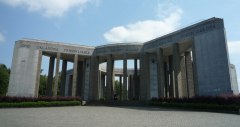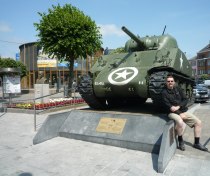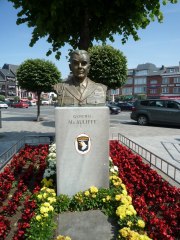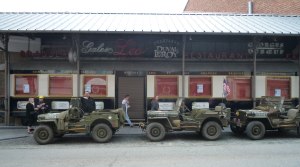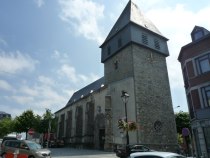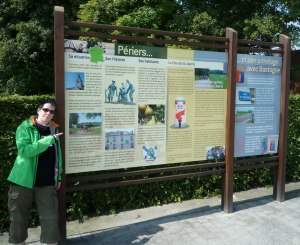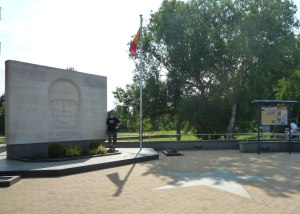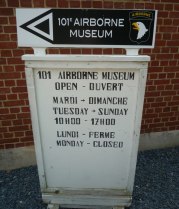Last year, we toured the Eastern Ardennes in Luxembourg and Eastern Belgium, visiting famous locations like Clervaux, St Vith, Ettelbrück, and Diekirch.
This year, we set up base camp in one of the most important (and certainly the most famous) locations of the Battle of the Bulge: in Bastogne.
From there, we visited places like Foy with the Easy Company foxholes, Recogne, Houffalize, and La Roche-en-Ardenne, where the US troops joined forces with the Scottish Highland Division.
All over the area, you can find relics and reminders of the Battle of the Bulge – memorials, museums, and even traces of combat still visible on the battlefields. This combined with the impressive landscape of steep rocky valleys, soft rural hills, dense woods, and tiny villages, the Belgian Ardennes are well worth a trip!
Please check out our photo gallery for MANY MORE photos!!
Bastogne
Despite the fact that there are certainly more picturesque places in the Ardennes, we decided to stay in a hotel in the noisy and congested crossroads town of Bastogne, which is situated on a ridge at an altitude of 510 m.
The strategical importance of this small city (about 14,000 inhabitants) lies in the fact that all roads within the Ardennes lead to and through Bastogne. This was the main reason why both sides were fighting desperately to get control over the city – who controls Bastogne, controls the road network of the entire region.
The same is still true today – and this is the reason why Bastogne can certainly be considered to be the traffic capitol of the Ardennes. The layout of the city is simple: one main road (with shops, bars, church), one giant parking space in the central square, surrounded by bars and restaurants, and a central crossroads with numerous roads leading out in all directions, reminding us of a spider’s net. A never-ending stream of cars rushes through the streets all day long, so Bastogne is easily the noisiest and busiest places in the quite and peaceful Ardennes.
Bastogne then…
Bastogne was captured by US forces in December 1944 and a strong perimeter around the city was built.
On December 20th, 1944, German forces under the command of Lt. General Freiherr von Lüttwitz managed to bypass Bastogne and encircle it. The besieged city was held by the 101st Airborne Division under the command of Brigadier General McAuliffe and elements of the 10th Armor Division, which were outnumbered by surrounding German forces 5-1. The situation in the besieged city was rough because medical supplies, food, and ammunition were soon running low. In addition, winter 1944 was one of the coldest winters ever recorded with temperatures dropping as low as -28°C / -18.4 F and the soldiers where not properly equipped with cold-weather-gear. In the beginning, there was no hope for air support or supply by air because of the bad weather.
Over the following days, the weather cleared and the Allies eventually managed to supply the surrounded soldiers by air drops. The Germans attacked the town relentlessly, but didn’t manage to break the defense line. This was frustrating for German command, so finally German commander von Lüttwitz requested the surrender of the forces in Bastogne. McAuliffe’s response was simple – and consisted of only one word: “Nuts!” (which can be roughly translated into German with: “Ihr spinnt wohl!”).
On December 26th, two of the German besieging forces where commanded to press forward and leave Bastogne behind, so that the only attackers left where Panzer Lehr’s 901st regiment and the 26th Volksgrenadier Division. Since both of these units where ill supplied and near to exhaustion, they were not able to continue the attack on Bastogne from all sides, but were limited to small assaults on certain points here and there. This wasn’t very effective, so in the end, the US forces managed to destroy all enemy tanks. On December 26th, the city was liberated by General Patton’s 4th Armor Division and a corridor to the Allied controlled parts of the Ardennes was opened.
…and Bastogne now
As mentioned before, Bastogne is still a crossroads town. The central square “Place General McAuliffe” was transformed into a giant parking lot. There is a tourist information next to the main road which almost exclusively sells war souvenirs – you can get anything from mugs, key rings, t-shirts with a “Nuts!” logo, posters, caps, postcards related to Bastogne, the USA, the 101st Airborne, and the Battle of the Bulge.
At the edge of the parking lot is a Sherman tank (which is the main tourist attraction and very famous among kids who love climbing on top of the tank) and a bust of General McAuliffe. The parking lot is surrounded by bars and restaurants of mixed quality.
Bastogne is located in the francophone part of Belgium, in Wallonie, so the dominant language is French. We made the experience that many locals only speak rudimentary English (if at all), so knowing at least some basic French expressions is highly recommended (and much appreciated by the locals). Many information boards and signs are in French only, in rare cases with a Flemish and sometimes with an English translation. Luckily, at least some information boards regarding the Battle of the Bulge are multilingual.
Despite the fact that there are lots of hotels in Bastogne as well as many restaurants, it isn’t the typical “tourist town” – we rarely saw any tourists at all and in the evening, we were almost exclusively among Belgians. Most battlefield tourists probably stay in one of the many beautiful and idyllic Ardennes villages, which are much more catered to tourism, with higher quality restaurants and bars.
Since everything in the Ardennes is in close proximity to each other, it doesn’t really matter where you set up your base camp. Last year’s Clervaux was perfect because it is probably the most central town in the Ardennes with everything within a 30 km radius (including Bastogne). If we had known how beautiful La Roche is, we probably would have booked a hotel there. Wiltz is also a very nice town with many cultural highlights.
But so we had the chance to make the curious experience of spending several nights in Bastogne, which was at least interesting, if not very relaxing, due to the constant traffic and the ugly parking lot which comprises the city center. At least there’s no problem to find a place for your car, but we had a car-house rented for our Mercedes because we remembered our experience in Arnhem, where all places to park your car cost 2,50 € per hour and parking spaces were limited.
In addition to everything related to the Battle of the Bulge, other touristic sights include the annual bicycle race Liège – Bastogne, the museum en Piconrue (a museum about religious art and popular belief in the Ardennes) and Eglise St Pierre, a Gothic church with a Romanic bell tower. The three bells were donated by veterans of the 101st Airborne, German Fallschirmjäger Regiment, and the Anciens Combattants de Bastogne to commemorate the destruction of Bastogne in 1944.
You can get a city map for free in the tourist information with the location of all relevant sites in and around Bastogne and the staff will gladly give you directions.
It’s difficult to get to Bastogne without car – the town had a railway station once, connected to Wiltz and St. Vith, but it was cut off from the railway net in 1984 because the route was unprofitable. So despite the fact that Bastogne is the central traffic hub of the Ardennes, it’s hard to reach with public transport. There is a central bus station and several bus routes lead to the city, but getting there by car is strongly recommended, or you will miss all important battlefield sites outside town, which are impossible to reach by public transport (if you are the sporting type, you could get there by bicycle, though, the area is very popular among bike and hiking tourists and the cycle and hiking path network is good and well signposted).
There are several museums in and around Bastogne dedicated to the Battle of the Bulge. Unfortunately, the largest one, “The Bastogne War Museum” is currently closed and under reconstruction. It will reopen in March 2014 as one of the largest and modern World War II museums in Europe.
Another large museum, the “Battle of the Bulge 44” museum (9 km outside of Bastogne, close to the Luxembourg border), was (theoretically) open, but each time we got there, it was closed – despite the fact that we went there during the official opening hours, so we finally gave up on visiting it.
The 101st Airborne Museum Bastogne
The 101st Airborne Museum is located in the town center, close to the central bus station. It is located in a historical building, the former officers’ mess of the Belgian army, which was later used as a German “Unteroffiziersheim” during the occupation of Bastogne. After the war, it served as a Red Cross hospital. The building was carefully restored and is a perfect location for a museum (as is the Villa Hartenstein in Arnhem-Oosterbek). The museum is quite new, modern and nicely styled.
What distinguishes this museum from the many other Bulge museums we visited during our tours, is the fact that there are no common shop window mannequins used for the dioramas – but lifelike, very realistic figures with highly detailed faces and expressions, reminding us of wax figures in Madame Tussaud’s. Every soldier and person depicted has an individual, expressive face and conveys strong emotions. So all dioramas appear to be realistic and naturalistic.
Together with these excellent mannequins, decent faint and classic music from hidden speakers conveys an almost pious atmosphere, in contrast to many other loud, crowded and colorful War museums. Especially remarkable are the “re-enactments” of famous photographs with life-size figures.



